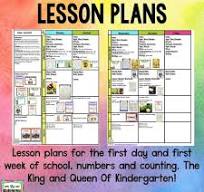
Creating a Fun and Engaging Lesson Plan for Kindergarten
Kindergarten is an important stage in a child’s education where they start to develop foundational skills that will set them up for future learning. A well-designed lesson plan can make learning enjoyable and effective for young learners. Here are some tips for creating a fun and engaging lesson plan for kindergarten:
Set Clear Learning Objectives
Define what you want your students to learn by the end of the lesson. Keep the objectives simple and age-appropriate.
Use Interactive Activities
Engage students with hands-on activities, games, songs, and group exercises. Make learning interactive and fun to keep their attention.
Incorporate Visual Aids
Use colorful visuals, charts, pictures, and props to help reinforce concepts and make learning more engaging for young learners.
Include Storytelling
Children love stories! Incorporate storytelling into your lesson plan to make learning more memorable and enjoyable.
Allow for Movement Breaks
Kindergarteners have lots of energy! Incorporate movement breaks into your lesson plan to keep them engaged and focused throughout the day.
Provide Positive Reinforcement
Praise students for their efforts and achievements to boost their confidence and motivation to learn.
Assess Learning Informally
Observe students during activities to assess their understanding informally. Adjust your teaching based on their responses to ensure effective learning.
In conclusion, creating a fun and engaging lesson plan for kindergarten involves setting clear objectives, using interactive activities, incorporating visual aids, storytelling, movement breaks, positive reinforcement, and informal assessment methods. By following these tips, you can create a dynamic learning environment that inspires young learners to explore, discover, and thrive!
Guide to Kindergarten Lesson Plans: Writing Tips, Examples, and Key Steps
- How to write a lesson plan for kindergarten?
- What are some lesson plans for kindergarten?
- What are the 5 steps of a lesson plan?
- What are the 5’e’s lesson plans for kindergarten?
How to write a lesson plan for kindergarten?
One frequently asked question in education is, “How to write a lesson plan for kindergarten?” Writing a lesson plan for kindergarten involves careful consideration of the young learners’ developmental needs and interests. It is essential to set clear learning objectives, incorporate interactive and hands-on activities, use visual aids, include storytelling elements, provide opportunities for movement breaks, offer positive reinforcement, and assess learning informally. By following these guidelines and tailoring the lesson plan to meet the unique needs of kindergarten students, educators can create engaging and effective learning experiences that promote curiosity, creativity, and growth in young learners.
What are some lesson plans for kindergarten?
When planning lessons for kindergarten, educators often focus on activities that cater to young learners’ developmental needs and interests. Some common lesson plans for kindergarten include thematic units such as colors, shapes, numbers, letters, seasons, and animals. Teachers may incorporate hands-on activities like arts and crafts, sensory play, music and movement, storytelling, and interactive games to engage students in learning. Additionally, lessons often integrate social-emotional learning components to help children develop important skills such as cooperation, empathy, and self-regulation. By providing a variety of engaging and age-appropriate activities within a structured framework, teachers can create a stimulating learning environment that supports kindergarten students’ growth and development.
What are the 5 steps of a lesson plan?
In creating a lesson plan for kindergarten, it is essential to follow a structured approach to ensure effective teaching and learning. The five steps of a lesson plan typically include: 1) Setting clear learning objectives that define what students should know or be able to do by the end of the lesson, 2) Planning engaging activities and resources that support the learning objectives and cater to different learning styles, 3) Introducing new concepts or skills through interactive teaching methods such as storytelling or hands-on activities, 4) Providing opportunities for guided practice and reinforcement of key concepts, and 5) Assessing student understanding through informal observations or formal assessments to gauge learning outcomes and adjust instruction as needed. By following these five steps, educators can create well-structured and engaging lesson plans that promote meaningful learning experiences for kindergarten students.
What are the 5’e’s lesson plans for kindergarten?
The 5E’s lesson plan model for kindergarten is a popular approach that follows the stages of engage, explore, explain, elaborate, and evaluate. This framework is designed to promote active learning and critical thinking skills in young learners. During the Engage stage, students become interested and motivated to learn about the topic. In the Explore stage, they participate in hands-on activities to investigate and discover concepts. The Explain stage involves the teacher providing explanations and clarifications. In the Elaborate stage, students apply their understanding through further activities or projects. Finally, in the Evaluate stage, students demonstrate their knowledge and skills through assessments. The 5E’s lesson plan model offers a structured yet flexible method for creating engaging and effective lessons for kindergarten students.
